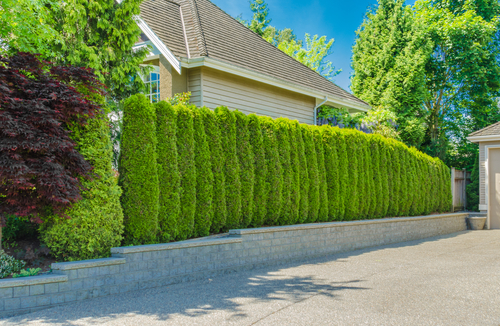
We all value our privacy, but that doesn’t mean we want garish fences on our property. Plants, such as trees and shrubs, make excellent privacy fences and barriers. And when combined with existing fencing, privacy plants make a property more appealing and comfortable.
Before You Plant: Understand Your Hardiness Zones
Plant hardiness zones refer to areas in which certain plants thrive. The USDA created these zones based on the minimum winter temperatures of the specific zones. In other words, these zones indicate if a plant can survive the typical climate of the area.
The Pacific Northwest falls into two sections of hardiness zones:
Zones 6a – 7a: The frost-prone areas east of the Cascades. These areas see winter minimums as low as -10 degrees F. At higher elevations, these zones change to 5a and 5b.
Zones 7b – 8b: The mild, coastal environments west of the Cascades. These zones allow for earlier planting due to milder winters.
When buying any plants, ensure they are compatible with your specific hardiness zone. The following suggestions will thrive within the Pacific Northwest’s diversity of hardiness zones.
Here are three great ideas for privacy fences in the Pacific Northwest.
- Manageable Living Walls with Skip Laurels
Laurels are well suited for living walls. They flower with small white flowers, and they’re naturally deer-proof. With foliage from the ground up, skip laurels are great additions for living wall backdrops, or even to fill gaps between walls.
Living walls also benefit from creep-style plants, like ivy. Ivy can drape in front of laurels, walls, or other growth to create depth and further privacy. Or, it might fill gaps between two different hedges. Don’t forget about potted plants and flower boxes. These make lovely additions to a living privacy barrier.
Common elements needed for living walls include:
- Lattice for growing ivy and other climbing plants.
- Strong-rooted plants to provide strength and added structure to existing fences.
- Personalized contributions, including perennials or flowering shrubs.
Living walls work great with other privacy elements. However, they do require plenty of maintenance, especially at the beginning, so start small. Pick a section of the property to make secure first, and then create a living wall.
- Create Majestic Native Barriers with Concolor Fir
Not every fence has to follow the traditional fence style. If you have a lot of property, embrace the alpine nature of the Pacific Northwest. Plant rows of Concolor Fir for a regal barrier made from native trees.
Concolor Firs provide ample shade and privacy. With boughs close to the ground, these trees keep out unwanted eyes from the ground up. And as they grow in cone shapes, a few trees can cover plenty of space.
Concolor Firs make excellent privacy choices, precisely because:
- They grow up to 2 feet a year, allowing for hands-on growth management and pruning.
- They can reach up to 50 feet tall and 25 feet wide at the base.
- The trees themselves are beautiful and add much value to the property.
Concolor Firs are great additions to any yard. They create a natural, alpine look for sizable properties. Also, as they can survive for hundreds of years, they provide your property with a great deal of generational value.
- Use Holly Amongst Your Fences
English Holly is an easily-managed evergreen plant. It naturally grows into a small tree-like thicket. Or, you can prune it into hedges amongst an existing fence. It also thrives in the mild climate of the Pacific Northwest. As well, its red berries offer a brilliant burst of color and food for birds.
When combined with existing fences, Holly provides pleasing green patches as an accent. Its hedge-growing qualities create a thick barrier that suits any wall. If left to continue growing, Holly reaches heights of 50 feet tall. Holly is thus very versatile for privacy uses across a property.
Accent pieces are another great way to break up the monotony. Benches, gates, or even fountains still maintain privacy without the look of a fence. Use accents and other low-maintenance landscaping options to boost the privacy of your yard. These include:
- Tall grasses along the perimeter of fences. Start small and use grasses to provide natural fence enhancement.
- Rain gardens incorporate trees, shrubs, and flowers to help capture and filter rain runoff. Use privacy plants to create a functional barrier that helps the environment.
- Potted privacy plants create modular barriers to adapt to your needs.
Not every privacy barrier needs to be a tree or shrub. Break up fencing with natural options like Holly or even specific accent pieces in order to create a pleasing and effective barrier.
Final Thoughts
Privacy shouldn’t take away from the beauty of your property. And while privacy fences keep out unwanted eyes and visitors, plants serve that same function.
Focus on hardy trees and shrubs that can cover a lot of ground. Look for trees with boughs and branches within the first four feet of the trunk. Plant them in a natural pattern. This ensures visual appeal as they grow.
Don’t forget accent pieces. From living walls to potted plants, privacy options don’t end at tall trees. Bright flower displays and environmentally-friendly rain gardens add value and function alongside privacy. Even if you already have a fence, grow Holly along it to create a living barrier with reinforced protection.
If you want to avoid the sterile look of a fence, turn to plants. This way, you can address your privacy concerns and increase your property value simultaneously.